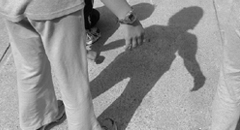
|

|

|
Among many other possibilities, documentation is visible listening.
The term documentation conjures up different meanings for different people. To our minds, one of the primary features of documentation as practiced in Reggio Emilia is a focus on how and what children learn. This focus is reminiscent of careful listening; thus, documentation, in many ways, is visible listening. Some of the elements of documentation include:
- conducting careful observations
- developing questions and tentative answers about how and what children are learning
- collecting evidence of individual and group learning
- interpreting observations and evidence in relation to your question(s)
- inviting others' interpretations
- using the information to guide future teaching
- starting all over again
Documentation can take many forms--observation notes, partial transcripts, audiotapes, a list of students' responses to a prompt, photographs or videos of individual and group learning, and adult or student analyses of or reflections on student work.
Documentation makes the "how" as well as the "what" of learning visible.
Even though in U.S. culture we tend to separate the "how" from the "what" of learning, we think the two are integrally linked. We suggest that the focus of documentation should be making learning visible (the title of this project!)--boththe acts and products of learning--as well as supporting and nurturing that learning. Consider the following quote from Vea Vecchi, an atelierista in the Reggio schools:
We feel it is necessary, once again, to deny the assertion that learning, and how we learn, is a process that cannot be seen, that cannot be activated and observed, leaving the school with the sole task of eliciting learning and then verifying it after the fact. What we are interested in is precisely an attempt to see this process and to understand how the construction of doing, thinking, and knowing takes place, as well as what sort of influences or modifications can occur in these processes.
Documentation has multiple meanings.
Again and again, we may ask, "What is documentation?" As our practice and understandings develop, we may generate multiple ideas about what documentation is. There is no single way to view this practice. Our Reggio colleagues have variously referred to documentation as:
- A conceptual tool... a way of thinking... a mental attitude... a culture... a tool for pedagogical research
- Visible listening
- A form of communication that needs to be created with others in mind
- "An integral part of the procedures aimed at fostering learning and for modifying the learning-teaching relationship." (Carlina Rinaldi, p.78, Making Learning Visible: Children as Individual and Group Learners)
- A critical part of the search to find or construct the meaning of school
- "The construction of traces (through notes, slides, videos, and so on) that not only testify to the children's learning paths and processes, but also make them possible because they are visible." (Carlina Rinaldi, p.83, Making Learning Visible: Children as Individual and Group Learners)
By centering our attention on adults' and childrens' learning, documentation can serve as a valuable teaching, research, and assessment tool.
Assessment does not have to be a post-mortem. In the U.S., when we think about documentation, we typically have more of a record-keeping than a learning mentality. The Reggio teachers see documentation as a research tool. They see schools as carrying out research on learning; both teachers and students reflect daily on the ways that we learn and acquire knowledge. Carlina Rinaldi suggests that pedagogical research can be understood as the "interpretations and reflections around the research of the children and with the children."
Looking at how children think and learn--the genesis of ideas and how they evolve--is not the only focus of Reggio documentation, but it is a central focus. The hypothesis for the MLV project was that documentation not only allows us to make visible-and hence come to know and support-the dynamics of individual and group learning, but also is itself a tool that can promote individual learning within the group as well as learning by the group as a whole. When their learning is documented, children can revisit and interpret their learning experiences and reflect on how to develop these experiences further. Interpretation and reflection become fundamental aspects of documentation that are not only retrospective, but also are projected toward the creation of future contexts for learning.
To find out more about the specifics of documentation, see Features of Documentation
[Home] [Site Map]